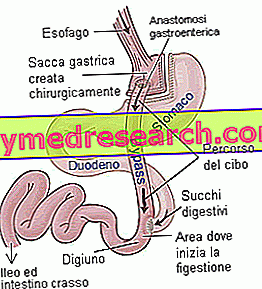Generality
Otoplasty is an operation of aesthetic surgery that remedies the imperfections of the ears: from the protruding ears, to those that are too large or malformed.

Figure: otoplasty on a child - From the site www.drbafitis.com
Like any surgical operation, otoplasty is not without its complications; these, however, are neither serious nor particularly frequent circumstances.
The traditional procedure is usually carried out by engraving the auricle in its rear part; however, this operational approach is not the only viable one.
In general, if the doctor's advice and precautions are observed, the results of otoplasty are good and satisfy those who have undergone it.
What is otoplasty?
Otoplasty is an operation of aesthetic surgery aimed at correcting the imperfections of the ears, such as the so-called protruding ears, the malformed ones or those too large and disproportionate.
The operation consists, in fact, in a remodeling of the cartilage of both auricles.
EXTERIOR EAR

The auricle is a cartilaginous structure of oval shape and covered with skin. The cartilage of the ear, consisting of an elastic and flexible tissue, has characteristic folds, which serve to channel sound waves into the ear.
THE EARS IN SVENTOLA
The so-called protruding ears (or protruding) are considered, for example, as an aquiline nose or a protruding chin, of hereditary anatomical characteristics, as it is more common to find them among members of the same family.
In individuals with normal ears, the angle between the auricle and the mastoid process of the temporal bone measures between 20 and 30 degrees; in people with protruding ears, this angle exceeds 30-35 degrees.
The protruding ears are considered only and exclusively an aesthetic defect, since they do not alter the hearing ability of a person.
DEVELOPMENT OF THE EARS
The auricles are among the first anatomical structures of the body to reach, at a young age, the final dimension: in the fifth year of life, in fact, their development can be considered completed.
During this time, the definitive cartilaginous tissue is formed.
When you run
In adults, otoplasty is a surgical procedure required above all by those who, having protruding or out-of-shape ears, feel uncomfortable or embarrassed. However, it is not excluded that the intervention may also be required to solve some problems of a practical nature, such as the protruding ear pain caused by a motorcycle helmet.
In younger individuals, on the other hand, it is usually the parents who solicit the intervention, as they feel a hidden malaise of the child, due to the mockery of schoolmates or peers. The minimum age, to carry out the operation on children, coincides with the moment in which the development of the ears and the auricular cartilage ceases, therefore around 5 years. Intervening with an otoplasty first may be useless and, in some cases, cause an abnormal growth of the ears.
risks
The otoplasty operation is considered not dangerous for the patient's safety.
However, this does not exclude that small complications may arise or that the intervention may not meet the expectations of the person who underwent it.
Here is a list of the main complications
- Obvious scars: the surgical incision behind the ears always leaves small post-surgery scars. However, in some cases, these signs can be obvious and unsightly. As will be seen, to avoid this inconvenience, a new type of otoplasty has been developed, called incisionless otoplasty (" otoplasty without incision ").
- Infections : may develop during incision. With an antibiotic treatment it is easy to remedy the problem. Neglecting an infection can lead to malformations of the entire auricle.
- Asymmetry : reshaping both ears of an individual symmetrically is not always possible and always easy. The skill of the aesthetic surgeon is very important, as far as we are concerned.
- Inflammation : since it affects the cartilage, it is called chondrite .
- Bruises, sense of numbness and hardening : they affect the cartilage and can take weeks or even months to fade completely. They are annoying, but they must not alarm the patient.
- Problems with sutures : Internal sutures are applied to fix cartilage remodeling. However, in some cases, after several months from the operation, they could be "expelled" and emerge from the skin: if this happens, we proceed with the removal of the seams, which is painless, followed by a second otoplasty operation.
- Dissatisfaction with the intervention : the patient may be disappointed by the intervention.
- Blood clot : may form at the incision site or in the surrounding area. It is not serious, but if it is not removed it can deform the ear.
- Classical disorders of any surgery : sudden bleeding, allergic reaction to anesthetics or materials used for surgery are rare but possible episodes.
Preparation
Before proceeding with the otoplasty procedure, the doctor submits the patient to various checks and examinations, to make sure that there is no contraindication to the operation.
We start with an assessment of the current health status associated with an inquiry into the clinical history, namely:
- What diseases have you suffered in the past?
- Have you ever suffered from hearing problems and ear infections?
- Are you taking medication?
- Have you undergone other surgical procedures in the past? If yes, did anesthesia cause problems?
If the profile that emerges from the answers is positive, it is difficult for post-operative complications to arise; vice versa, in some circumstances, the intervention could even be contraindicated.
It continues with a physical examination, which analyzes the shape, position and size of the ears. Based on the anatomy of the auricle, the surgeon will plan the most appropriate operating procedure.
It ends with a discussion of the reasons that lead the patient to request the intervention and his expectations in this regard. Although they do not really affect health, these aspects are also important, as they serve the doctor to understand the patient's needs.
WHAT TO AVOID TO DO BEFORE INTERVENTION
In preparation for the surgical operation (and also during hospitalization), it is good practice:
- Quit smoking, because smoking alters blood flow, therefore also the healing process.
- Avoid certain medications, such as aspirin and medicinal herbs because they tend to slow down blood clotting and promote blood loss (bleeding).
Procedure
In adults, otoplasty is considered an outpatient surgery, as it is performed under local anesthesia and does not require post-intervention hospitalization.
In children, on the other hand, things are slightly different: general anesthesia is foreseen, that is the complete unconsciousness of the patient, and the admission of a day for precautionary reason (it is a good rule, in fact, to monitor for at least one night the subjected individual at general anesthesia).
The operative techniques, with which otoplasty can be performed, are mainly two:
- Otoplasty by incision
- Otoplasty without incision, or incisionless
ANESTHESIA
During local anesthesia, the adult patient is conscious, but does not feel any pain in the area to be operated. Often, anesthetics are also accompanied by sedatives, to calm and relax the person who is about to undergo surgery.
During general anesthesia, however, the child is unconscious, as well as insensitive to pain. Anesthetics and painkillers are administered before starting the operation and until the end of this.

Figure: incision site on the auricle and example of internal sutures on the cartilage. From the site www.carolinafacialplasticsurgery.com
Before general anesthesia, it is recommended to refrain from eating and drinking, to avoid unpleasant (and sometimes even dramatic) complications.
OTOPLASTY BY ENGRAVING
The otoplasty by incision is the most practiced method and is carried out in the following way.
By practicing a vertical cut in the back of the ear, the surgeon can reshape the ear as planned at the beginning of the operation. The remodeling involves sections, removal of cartilaginous material, repositioning, etc. All these adjustments are welded and kept in place by internal sutures, which are no longer removed, provided that no complications arise.
When the restoration is considered finished, the surgeon closes the cut with temporary points and applies a bandage, similar to a turban, around the head of the patient.
Advantages and disadvantages of engraving otoplasty
- Advantages: ample remodeling margin.
- Disadvantages: requires an incision, which can leave noticeable scars, despite being in a hidden place of the head (behind the ear)
NB: the final bandage is performed only after intervening on both ears.
INCISIONLESS OTOPLASTICS
Incisionless otoplasty is an innovative method, designed to avoid cutting into the auricle and thus causing noticeable scars.
The operation is performed by applying, with a needle, internal sutures that improve the deformities of the ears. In fact, no cartilage material is eliminated, but only permanent corrective seams are applied.
Everything is done under the skin, so the external appearance appears normal.
Advantages and disadvantages of incisionless otoplasty
- Advantages: there are no incisions and all the complications related to them; it can be done in less than an hour; the patient can immediately return to his normal activities.
- Disadvantages: limited remodeling margin, as cartilage is not eliminated, but relies only on internal corrective sutures.
DURATION OF THE INTERVENTION
If the incisionless otoplasty is very fast, the one that involves the engraving of the auricle requires much more time: from a minimum of 2 hours to a maximum of 5, depending on the changes to be made.
Post-operative recovery
During the first 48 hours after otoplasty, it is good to remain at complete rest .
After this period of time, you can gradually return to the classic daily activities, avoiding excessive efforts and all those potentially risky situations.
THE BANDAGE
The protective bandage, applied at the end of the otoplasty with incision, must be maintained for a few days, generally no more than a week. After that, the only recommended protection is a delicate band, to be applied around the head, for 3-6 weeks, in order to protect the ears during the night. If it is possible, in this space of time, it would be better to sleep with the head raised or, at least, without leaning on one side.

Figure: protective band for the ears, to wear during the night.
From the site: solomonfacialplastic.com
Without these precautions, one runs the risk of traumatizing the ears, reopening the incisions and slowing healing.
HYGIENE
The turban helps keep the area operated from possible bacterial and viral infections.
It is advisable not to wash the hair, at least until the bandage has been removed: in fact, as long as the incision has not completely healed yet, there is no need to wet it.
POST-OPERATIVE PAIN
It is normal to feel pain, tingling and numbness in the ear, as it is normal to notice bruising and redness in the areas affected by the otoplasty procedure.
To reduce the painful sensation, anti-inflammatory drugs are recommended, such as paracetamol and ibuprofen, while aspirin is not recommended, which could cause side effects (bleeding).
Within a couple of weeks, if all goes well, the situation returns to normal.
If, on the other hand, no improvement is observed or even the intensity of pain increases, it is advisable to consult your doctor.
RETURN TO SCHOOL OR WORK
Adult persons can return to work already one week after surgery, taking care to avoid all potentially risky situations. It is clear that this recommendation also depends very much on the work performed.
As far as children are concerned, it is advisable to wait a couple of weeks before returning to school, as the school environment exposes more easily to physical trauma, clashes, contacts, etc.
WHEN CAN YOU RESUME THE ACTIVITY? NORMAL PHYSICS?
The return to normal physical activity depends on the activity that usually takes place.
For example, the return to an activity like swimming takes 8 weeks; return to rugby or football, on the other hand, requires at least 12 weeks.
In general, sports where physical contact is required require longer periods of abstention from activity than sports with reduced physical impact.
Results
Except for rare circumstances (which can however be remedied by a second intervention), otoplasty is a safe operation that meets the needs of patients.



